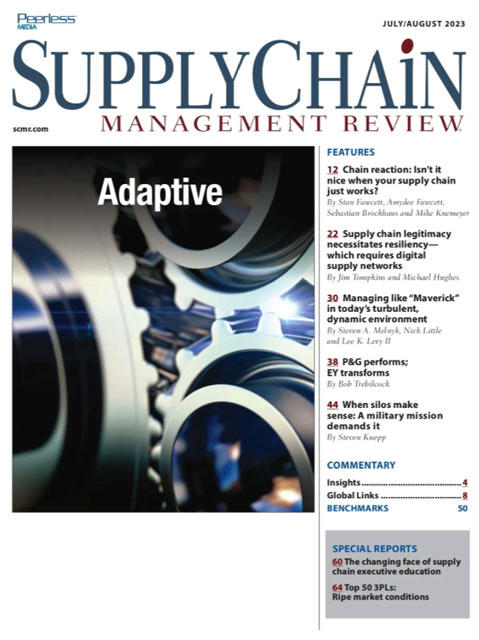Sorry, but your login has failed. Please recheck your login information and resubmit. If your subscription has expired, renew here.
July-August 2023
Most business people have heard the phrase “move fast and break things.” But how do you move fast, break things, and remain profitable? Inside this issue of Supply Chain Management Review are the answers—we hope. We have two articles this month that address decision-making. The articles (“Chain reaction: Isn’t it nice when your supply chain just works?” and “Managing like ‘Maverick’ in today’s turbulent, dynamic environment”) approach the topic of decision-making from decidedly different perspectives, but I believe they are more similar than they appear. Browse this issue archive.Need Help? Contact customer service 847-559-7581 More options
Last year saw the release of Top Gun: Maverick—an American action-drama film. This 2022 film saw the hero, Peter “Maverick” Mitchell, overcome obstacles and successfully achieve his objectives by relying on fast decision-making. For the world of combat involving jet fighters, such decision-making is necessary for survival. After all, you are operating in a world where airplanes are engaged in combat at speeds ranging between 1,000 mph to 1,600 mph (which means that they are closing with speeds double that). You must make decisions quickly; waiting to be sure often results in you being dead. These insights not only apply to the world of jet warfare; they are also relevant to the supply chain manager working in today’s highly dynamic and turbulent environment. This is a world in which data is ever increasing and pervasive; data is often incomplete and conflicting; uncertainty replaces risk. In such an environment, decision-makers, especially supply chain managers, must be prepared to act quickly and decisively. Like the jet fighter pilot, you cannot often afford to wait for things to clear up.
The return of Maverick
However, Maverick is important for other reasons. First, Maverick’s actions are not ad hoc or taken from the hip. Rather, they are the result of a well-defined process that every jet fighter uses—the OODA (observe-orientate -decide-act) loop—a process first developed by Col. John R. Boyd. This process can be recast into a supply chain specific process referred to as the strategic response cycle (SRC). As will be shown in this article, it is this process that enables effective supply chain management decisions with a high degree of confidence in the actions decided upon. Next, Maverick’s actions take place within an organizational structure and culture that recognizes the importance for risk taking, differentiates between “smart” and “dumb” failures, and that is highly robust (as opposed to being optimal).
The message communicated by this article is simple—today’s supply chain demands quick, effective decision-making; today’s supply chain manager has more in common with Maverick than they may be aware of. Furthermore, this is not a new message. In a previous article published in this journal (Melnyk, 2016), we talked about the emergence of the new strategic supply chain leader. A critical trait of this new leader was that of fast decision-making. That observation, made in 2016, has picked up more relevance and urgency in today’s dynamic, turbulent, and uncertain business climate.
However, to understand the origins of this concept and this article, it is necessary to start at the beginning with a plant visit that took place in September 2015.

This complete article is available to subscribers only.
Log in now for full access or start your PLUS+ subscription for instant access.
SC
MR
Sorry, but your login has failed. Please recheck your login information and resubmit. If your subscription has expired, renew here.
July-August 2023
Most business people have heard the phrase “move fast and break things.” But how do you move fast, break things, and remain profitable? Inside this issue of Supply Chain Management Review are the answers—we… Browse this issue archive. Access your online digital edition. Download a PDF file of the July-August 2023 issue.Last year saw the release of Top Gun: Maverick—an American action-drama film. This 2022 film saw the hero, Peter “Maverick” Mitchell, overcome obstacles and successfully achieve his objectives by relying on fast decision-making. For the world of combat involving jet fighters, such decision-making is necessary for survival. After all, you are operating in a world where airplanes are engaged in combat at speeds ranging between 1,000 mph to 1,600 mph (which means that they are closing with speeds double that). You must make decisions quickly; waiting to be sure often results in you being dead. These insights not only apply to the world of jet warfare; they are also relevant to the supply chain manager working in today’s highly dynamic and turbulent environment. This is a world in which data is ever increasing and pervasive; data is often incomplete and conflicting; uncertainty replaces risk. In such an environment, decision-makers, especially supply chain managers, must be prepared to act quickly and decisively. Like the jet fighter pilot, you cannot often afford to wait for things to clear up.
The return of Maverick
However, Maverick is important for other reasons. First, Maverick’s actions are not ad hoc or taken from the hip. Rather, they are the result of a well-defined process that every jet fighter uses—the OODA (observe-orientate -decide-act) loop—a process first developed by Col. John R. Boyd. This process can be recast into a supply chain specific process referred to as the strategic response cycle (SRC). As will be shown in this article, it is this process that enables effective supply chain management decisions with a high degree of confidence in the actions decided upon. Next, Maverick’s actions take place within an organizational structure and culture that recognizes the importance for risk taking, differentiates between “smart” and “dumb” failures, and that is highly robust (as opposed to being optimal).
The message communicated by this article is simple—today’s supply chain demands quick, effective decision-making; today’s supply chain manager has more in common with Maverick than they may be aware of. Furthermore, this is not a new message. In a previous article published in this journal (Melnyk, 2016), we talked about the emergence of the new strategic supply chain leader. A critical trait of this new leader was that of fast decision-making. That observation, made in 2016, has picked up more relevance and urgency in today’s dynamic, turbulent, and uncertain business climate.
However, to understand the origins of this concept and this article, it is necessary to start at the beginning with a plant visit that took place in September 2015.
SC
MR


Latest Supply Chain News
- Few executives believe their supply chains can respond quickly to disruptions
- Technology’s role in mending supply chain fragility after recent disruptions
- Tech investments bring revenue increases, survey finds
- Survey reveals strategies for addressing supply chain, logistics labor shortages
- Israel, Ukraine aid package to increase pressure on aerospace and defense supply chains
- More News
Latest Podcast

 Explore
Explore
Business Management News
- Few executives believe their supply chains can respond quickly to disruptions
- Technology’s role in mending supply chain fragility after recent disruptions
- Survey reveals strategies for addressing supply chain, logistics labor shortages
- How CPG brands can deliver on supplier diversity promises
- How S&OP provides the answer to in-demand products
- AI, virtual reality is bringing experiential learning into the modern age
- More Business Management
Latest Business Management Resources

Subscribe

Supply Chain Management Review delivers the best industry content.

Editors’ Picks






